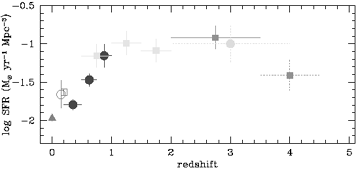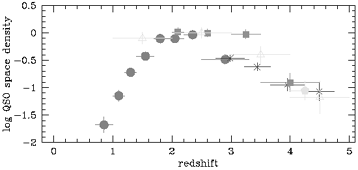


The 1980s were ripe with interesting ideas about the early Universe inspired by speculations about the unification of the forces and particles of nature (see e.g., Kolb & Turner 1990). For example: relic elementary particles as the dark matter; topological defects as the seeds for structure formation; baryon number violation and C, CP violation as the origin of the baryon asymmetry of the Universe (baryogenesis); and inflation. From all this, a compelling paradigm for extending the standard cosmology has evolved: Inflation + Cold Dark Matter. It is bold and expansive and is being tested by a flood of observations. It may even be correct!
The story begins with a brief period of tremendous expansion -
a factor of greater than 1027 growth in the scale factor in
10-32 sec.
The precise details of this ``inflationary phase'' are not
understood, but in most models the exponential expansion is driven by the
(potential) energy of a scalar field initially displaced from the minimum
of its potential energy curve. Inflation blows up a small, subhorizon-sized
portion of the Universe to a size much greater than that of
the observable Universe today. Because this subhorizon-sized
region was causally connected before inflation, it can be expected
to be smooth - including the very small portion of it that
is our observable part of the Universe. Likewise, because
our Hubble volume is but a small part of the region that inflated,
it looks flat, regardless of the initial curvature of the region
that inflated, Rcurv >>
H0-1, which via the Friedmann
equation implies that  0 = 1.
0 = 1.
It is while this scalar field responsible for inflation rolls slowly down its potential that the exponential expansion takes place (Linde 1982; Albrecht & Steinhardt 1982). As the field reaches the minimum of the potential energy curve, it overshoots and oscillates about it: the potential energy of the scalar field has been converted to coherent scalar field oscillations (equivalently, a condensate of zero momentum scalar-field particles). Eventually, these particles decay into lighter particles which thermalize, thereby explaining the tremendous heat content of the Universe and ultimately the photons in the CMB (Albrecht et al. 1982).
Quantum mechanical fluctuations arise in such a scalar field
that drives inflation; they are on truly microscopic scales
( 10-23
cm). However, they are stretched in size
by the tremendous expansion during inflation to astrophysical scales.
Because the energy density associated with the scalar field depends upon its
value (through the scalar field potential energy), these fluctuations
also correspond to energy density perturbations, and they are
imprinted upon the Universe as perturbations in the local curvature.
Quantum mechanical fluctuations in the space-time metric give
rise to a stochastic, low-frequency background of gravitational waves.
10-23
cm). However, they are stretched in size
by the tremendous expansion during inflation to astrophysical scales.
Because the energy density associated with the scalar field depends upon its
value (through the scalar field potential energy), these fluctuations
also correspond to energy density perturbations, and they are
imprinted upon the Universe as perturbations in the local curvature.
Quantum mechanical fluctuations in the space-time metric give
rise to a stochastic, low-frequency background of gravitational waves.
The equivalence principle holds that local acceleration cannot
be distinguished from gravity; from this it follows that
curvature perturbations ultimately
become density perturbations in all species - photons, neutrinos,
baryons and particle dark matter. The shape of the spectrum of perturbations
is nearly scale-invariant. [Such a form for the spectrum
was first discussed by
Harrison (1970).
Zel'dovich, who appreciated the merits of such a spectrum early on,
emphasized its importance for structure formation.]
Scale-invariant refers to the fact that the perturbations in the
gravitational potential have the same amplitude on all length
scales (which is not the same as the density perturbations having the
same amplitude). When the wavelength of a given mode crosses
inside the horizon ( =
H-1), the amplitude of the
density perturbation on that scale is equal to the perturbation
in the gravitational potential.
=
H-1), the amplitude of the
density perturbation on that scale is equal to the perturbation
in the gravitational potential.
The overall amplitude (or normalization) depends very much upon the specific model of inflation (of which there are many). Once the overall normalization is set, the shape fixes the level of inhomogeneity on all scales. The detection of anisotropy on the scale of 10° by COBE in 1992 and the subsequent refinement of that measurement with the full four-year data set permitted the accurate (10%) normalization of the inflationary spectrum of density perturbations; soon, the term COBE-normalized became a part of the cosmological vernacular.
On to the cold dark matter part; inflation predicts a flat Universe (total energy density equal to the critical density). Since ordinary matter (baryons) contributes only about 5% of the critical density, there must be something else. The leading candidate is elementary particles remaining from the earliest moments of particle democracy. Generically, they fall into two classes - fast moving, or hot dark matter; and slowly moving, or cold dark matter (see Sadoulet 1999). Neutrinos of mass 30 eV or so are the prime example of hot dark matter - they move quickly because they were once in thermal equilibrium and are very light. Axions and neutralinos are examples of cold dark matter. Neutralinos move slowly because they too were once in thermal equilibrium and they are very heavy. Axions are extremely light but were never in thermal equilibrium (having been produced very, very cold).
If most of the matter is hot, then structure in the Universe forms from the top down: large things, like superclusters form first, and fragment into smaller objects such as galaxies. This is because fast moving neutrinos smooth out density perturbations on small scales by moving from regions of high density into regions of low density (Landau damping or collisionless phase mixing). Observations very clearly indicate that galaxies formed at redshifts z ~ 2-4 (see Fig. 11), before superclusters which are just forming today. So hot dark matter is out, at least as a major component of the dark matter (White et al. 1983). This leaves cold dark matter.

|

|
Figure 11. Star formation rate in galaxies is plotted vs redshift. Bottom: The number density of quasi-stellar objects (galaxies with accreting black holes) vs redshift. The points have been corrected for dust and the relative space density of QSOs (from Madau 1999) |
Cold dark matter particles cannot move far enough to damp perturbations on small scales, and structure then forms from the bottom up: galaxies, followed by clusters of galaxies, and so on (see e.g., Blumenthal et al. 1984). For COBE-normalized cold dark matter we can be even more specific. The bulk of galaxies should form around redshifts z ~ 2-4, just as the observations now indicate.
At present, the cold dark matter + inflation scenario looks very promising - it is consistent with a large body of observations: measurements of the anisotropy of the CMB, redshift surveys of the distribution of matter today, deep probes of the Universe (such as the Hubble Deep Field), and more (see Liddle & Lyth 1993 and Fig. 11). While the evidence is by no means definitive, and has hardly begun to discriminate between different inflationary models and versions of CDM, we can say that the data favor a flat Universe, almost scale-invariant density perturbations, and cold dark matter with a small admixture of baryons.